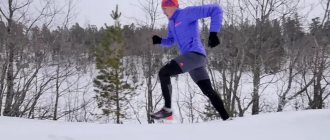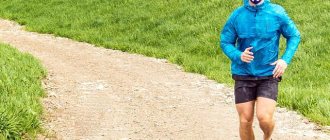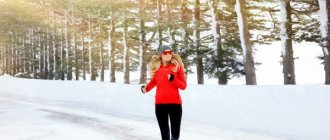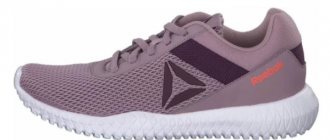In this article we will look at what to run in in winter, what sneakers and clothes to choose for running in winter.
One of the main advantages of running is that you can do it all year round and in any weather. With the advent of the first cold weather, there is a temptation to hibernate and abandon regular outdoor exercise.
There are many excuses for this, and the first of them is the fear of freezing and getting sick. But with the right equipment, the chance of getting sick becomes close to zero. And then, despite the weather conditions, you will enjoy the training process.
Master of Sports, finalist of the World and European Championships, member of the Russian national orienteering team, personal trainer for long-distance running Nina Verkhoglyadova-Temyakova, who during her rich sports career managed to run in all kinds of weather conditions and in various climatic zones, will share her experience.
If the winter turned out to be dry and not very cold, pay attention to the article about what to run in in the fall.
Many new runners wonder if they should run in winter. Yes need! Winter is the best time to lay the foundation, create a base that will soon significantly improve your results.
More experienced runners know that November-December is the time for long cross-country runs that increase overall physical endurance and increase the number of mitochondria in the muscles. It is worth noting that physiologically cold is more suitable for training than heat.
Subscribe to “Marathon Man” on Telegram. Announcements of articles and useful selections every week.
While many runners tend to change the stadium for an arena only after hearing the weather forecast about sub-zero temperatures, experts recommend doing most of the training outdoors.
For residents of those regions where snow cover prevails from November to March, cross-country training is involuntarily complemented by strength training, since the snow creates additional resistance. In this case, you should pay attention to the speed at which you run the development cross (it should be slightly lower than in the warm season).
On topic: How to run outside in winter
Often, beginners do not want to run in winter for fear of freezing and getting sick. In fact, most often a cold may occur not during training, but immediately after its completion. If you have a remote workout, and not just a run “from home and back,” then you need to follow simple rules.
It is extremely important to change completely into dry clothes immediately after finishing your workout. Even if it is severely frosty outside, the body has a reserve of thermal energy obtained as a result of the training process, and this warmth will be retained for no more than 5-7 minutes after stopping, and this is the time you have to completely change clothes .
Special requirements for “winter” clothing and running shoes
A light weight
Many layers - a lot of weight. But no. If you don’t want to look like a beefy penguin at the zoo, then choose clothes for training in winter from the “running” collections - they take into account the fact that you should be warm and that you will need to actively move.
Thermal insulation
Winter “running” collections must have insulation; it is used in an amount sufficient to protect the owner from freezing. At the same time, the insulation layer and the design of the clothing are such that you do not overheat even during intense workouts. To compensate for overheating, it is recommended to use clothing with built-in additional ventilation with zippers that can be opened when you are too hot.
Wind protection
There will be an icy wind and you will definitely need protection from it. That is why collections of clothes and shoes for winter always contain special fabrics and membranes that protect from the wind.
Visibility in the dark
Sports activities in winter often end in the dark. This means that there is a need for your safety to be clearly visible at dusk. Special inserts and applications of reflective paint also predominate in weight and volume in the “winter” collections.
Quick drying and waterproof
Membranes, dense fabrics, thermal insulation materials that absorb moisture well, waterproof zippers, and water-repellent impregnation are mandatory elements. They should protect the runner well from precipitation and piercing winds, dry quickly from body heat and prevent freezing.
Good adhesion to slippery surfaces
This applies, first of all, to sneakers, which should “hold” their owner well on dense snow and ice.
Is running in winter bad for your health?
Benefit
- The benefit of running in winter is that running training strengthens the body, improves immune defense and improves health.
- A slippery surface forces more muscles to work than when running on dry asphalt. As a result, the muscles of the hips, buttocks, ankle joint and calf muscles are strengthened much better than when running in the summer.
Harm
- The harm is primarily associated with the risk of injury on slippery surfaces, but this is only possible when using the wrong shoes. For beginner runners, experts do not recommend running at temperatures below 20 degrees - you can burn your lungs.
However, we must not forget about different climate zones. For example, in the steppe regions (where there is always a strong wind) -15 will be much more difficult to bear than the Ural -30. In addition to temperature, pay attention to air humidity: the higher the humidity, the more difficult it is to tolerate sub-zero temperatures.
- To avoid injury, muscles need to be well stretched before jogging. If this is not done, then at the beginning of the cross-country, cold muscles and ligaments may not withstand the load and tear.
Conclusion: running in winter has a positive effect on the athlete’s health.
Socks and knee socks
The requirements for socks and knee socks for the winter period are very simple: they must be thicker, warmer than socks and knee socks for the off-season and summer and higher, i.e. reach the top of the calf.
Tight fit. Socks should not move even minimally on the leg. A tight fit should not restrict the freedom of movement of the toes - usually an elastic insert is made in this area that fits the foot tightly. The “elastic band” should not pinch the leg in the calf area.
In winter, you should definitely use socks with added wool or artificial fibers for insulation.
Benefits of jogging in winter
Most people stop running in winter because they are afraid of catching a cold. The body acclimatizes quite quickly, which reduces the risk of getting sick by inhaling cold air to a minimum.
By continuing to run in winter, a person gets the opportunity to:
- keep yourself in good shape all year round, and not just during “favorable” weather;
- harden the body, which manifests itself in less susceptibility to colds.
Winter jogging is certainly useful, but requires compliance with certain safety measures.
Thermal underwear
Winter is a time for mandatory use of thermal underwear, which wicks moisture away from the body during active running.
Thanks to the right combination of natural and synthetic threads, sweat in such models is easily absorbed and easily evaporates out, the body does not freeze from cold air penetrating under clothes, and thermal underwear does not accumulate an unpleasant odor. Thermal underwear that is properly selected for the training temperature, even if it gets wet, will still keep you warm in cold weather. You can easily find out the comfortable temperature range for using thermal underwear using the information printed on the packaging. For warm weather (from 0 to -5C) use regular models, for cold weather (from -5C and below) - with the addition of merino wool.
Thermal underwear, which uses special antibacterial impregnations and weaves threads in several layers, differs significantly in functionality and if you want a warm and durable thing, it makes sense to buy just such models.
Good thermal underwear is distinguished by the following details:
1. Flat seams are essentially the standard for clothing that comes into direct contact with the skin.
2. Special shape of the cuffs - in order to prevent cold air from penetrating even through small holes to a hot body, in some models of thermal underwear, elastic lycra cuffs are sewn at the ends of the sleeves, often with holes for the thumbs, which also protects the palms of the hands from freezing.
3. Collar – a stand-up collar to protect the throat from the wind. It is advisable to buy models with a stand-up collar that will protect your throat from cold air. If possible, take thermal underwear with a zipper on the collar to quickly adjust the thermal insulation in case of overheating.
4. Inserts made of mesh or thin, elastic fabric for ventilation and inserts made of dense fabric for protection from cold winds. They are needed for greater freedom of movement, greater heat dissipation, in those areas where excess heat and sweat are formed: in the armpits and on the sides of the body, protection from wind in the chest area.
Models of thermal underwear for winter can be viewed here
Head, neck and hands - keep warm
The choice of hats and buffs is large, and from all this variety it is worth highlighting the Polar series buffs from Buff with a fleece lining, which will be especially relevant in cold weather:
Buff Polar
Buff Polar Neckwarmer
and the Brilliant 2.0 series from Craft with reflective print:
Craft Brilliant 2.0
A warm and functional hat with reflective print, perfect for running in cold weather.
Craft Brilliant 2.0 Thermal
Comfortable gloves with an ergonomic cut, designed for running in cold weather.
For harsher weather conditions, consider gear from Under Armor and Craft using Windstopper:
Under Armor Windstopper Beanie 2.0
Hat made of double jersey with protection from rain and wind. Warm fleece interior, technical fabric exterior with water-repellent UA Storm finish.
Under Armor UA Storm Windstopper Gaiter
The buff is made of double dense knitwear, has water-repellent properties and protects from wind.
Craft Power XC Windstopper
There is a windproof membrane on the wrists, insulation inside, and wear-resistant leather on the palms.
Craft Active Extreme 2.0 Windstopper
Flat seams, good thermoregulation, front membrane for protection from wind.
“Second layer”: fleeces and vests
A mandatory “winter” piece of equipment. Fleeces and vests are an excellent insulation option, a second layer between the jacket and thermal underwear. Depending on the temperature of use and the strength of the wind, you need to choose from thick ones, with thick fabric inserts and windproof membranes, such as Windstopper, to thin fleeces and vests. Insulating vests are convenient to use as an additional thermal insulating layer during active sports and as dry clothing that you can quickly put on immediately after training to avoid freezing.
We recommend that you choose models with a hood and cuffs. The hood protects the neck and head area well from cold air and piercing wind when raised, and the cuffs, especially if there is a slot for the thumb, very conveniently protect the wrist and palm from frost and wind.
Follow the links to see examples of fleece and running vest models
Tips for dressing in different weather conditions
Winter is a time of year when it is not necessary (especially in the southern regions) that there will be frost outside and snow underfoot. Winter thaws present special challenges for runners. At the same time, ice after them is especially dangerous. To avoid falls, it is recommended that you first take more care of your sports shoes. For example, these could be sneakers with metal spikes. Moreover, the spikes should be distributed not only on the toes, but throughout the entire sole. This is necessary to avoid possible dislocations when the heel partially slips. There are also clip-on studded shoe linings. They are quite strong and durable.
To protect against slush during the winter thaw, you need to make sure your sports shoes are waterproof. For example, these could be trail running shoes. You can also wear waterproof shoe covers for winter running.
To run through snowdrifts, sneakers must be made of dense material and well sealed from snow getting into them. The sole should be made of soft rubber.
And let’s also mention one detail for winter running. These are reflectors. Winter days are short, and it is not always light enough outside during a morning (or evening) run. And in order to become clearly visible to car drivers, runners should provide various special reflectors on their clothing. They can be attached both to clothing and to the back of sneakers (above the heel).
Jackets
The main features of running jackets in winter are wind protection, protection from cold and evaporation outward - from thermal underwear and fleece/vests of excess moisture and heat. For training in relatively warm weather, you can use jackets without insulation, with single-layer fabric, such as softshell, with windproof membranes. Very often, jackets use “zoning” of the use of membranes and dense fabric - for example, the chest area is protected by water and windproof fabric, and the back is made of fabric that evaporates excess moisture well. A prerequisite for jackets for cold weather is the presence of a stand-up collar that protects the neck area. A desirable condition is the presence of a hood, adjustable using tightening systems.
Models of light jackets can be viewed here
For frost and wind, it is better to use either “running” models with insulation, or jackets with thicker fabrics and insulation from other collections: for cross-country skiing, for hiking and mountaineering.
-30%
Running jacket Loeffler 2018-19 primaloft hotbond red
13 300 19 000
-30%
Running jacket Loeffler 2018-19 primaloft 100 lime
16 100 23 000
-30%
Outdoor Fleece The North Face 2020 m tansa softshell urban navy
7 763 11 090
What do modern manufacturers offer?
The most popular currently is thermal underwear from the company Craft. Let's see what lines of underwear this manufacturer offers, what advantages and reviews it has.
If you believe the statistics, modern athletes prefer Craft thermal underwear because all models of such clothing are designed for use under conditions of intense physical activity. Thus, professional runners choose models from the Craft Active Extreme sports line. The clothing from this collection is predominantly made of synthetic materials, which perfectly remove moisture outside and at the same time create an optimal microclimate inside. These are the most universal models, which are designed for operation in a wide temperature range (-20⁰С - +15⁰С).
Also among runners who prefer to exercise outdoors in winter, models from the Craft Warm line are popular. This clothing is characterized by a high level of moisture removal and the ability to retain heat in low temperatures (according to the manufacturer itself, the models in this collection can be used at temperatures from 0⁰С to -30⁰С). The composition of such underwear contains not only predominant synthetic fibers, but also wool, due to which it is considered a suitable option for autumn-winter jogging.
There are many other models of thermal underwear that are offered for sale by different manufacturers: RedFox, Lopoma, ODLO, X-bionik, Brubeck, Guahoo, Norveg and many others. Any consumer can become confused by such a variety of products. Therefore, before buying this or that model, be sure to first read what reviews and characteristics it has.
Running caps
It would seem that everything is simple with hats - take and put on an ordinary ski cap and run in it, but no. During active movement, the maximum amount of heat is released from the head; accordingly, a running cap should:
- Actively evaporate heat and remove moisture;
- Protect your wet head from the icy wind;
- Have a shape that protects the ears well;
- Have a form-fitting shape to fit snugly to the head;
The best models of running caps have fabric “zoning”: denser inserts, using windproof membranes, are sewn into the “frontal” part, less dense ones, which evaporate moisture well, are sewn into the back of the head.
-40%
Bjorn Daehlie hat 2016-17 hat polyknit flag high risk red
534 890
athlete price
Hat Bjorn Daehlie 2019-20 polyknit flag black
2 090
Buy
athlete price
Asics 2017-18 winter beanie hat black
1 690
-30%
Set (Hat + Gloves) Asics 2018-19 running pack performance black
1 323 1 890
Buy
A few words about shoes
Shoes for running in winter, like clothing, must be selected specifically taking into account the needs of the athlete and the operating conditions. And nowadays, buying suitable sneakers for jogging in the cold season is not difficult, since all self-respecting companies have long begun to produce special shoes for athletes on the market.
Companies that have established themselves as specializing in the production of winter running shoes and have received positive feedback: Nike, Salomon, Asics, Mizuno, Adidas, Saucony.
When making sports shoes for runners, they use modern Gore-Tex technology, thanks to which the athlete’s foot can “breathe” during active training due to special holes, but moisture from the outside will not penetrate through these same holes, which will ensure dry feet. There are also many other modern technologies that are used by sports shoe manufacturing companies (the same Nike, Asics, Solomon, Adidas and others), which make it possible to create comfort for the feet while jogging.
It is worth noting that currently there are no problems with purchasing suitable shoes for running in winter. You can buy special sneakers or boots at any sporting goods store.
When choosing a pair, pay attention to such a detail as the sole. Shoes designed for winter running come with a special sole that prevents slipping. Thanks to her, jogging will be not only comfortable, but also absolutely safe.
Professional runners who regularly exercise outside in winter are also advised to purchase ice shoes. By wearing them, you will be able to run in any conditions and on any terrain without worrying about your health.
Headlamps
For your comfort and safety during evening runs, we recommend stocking up on good flashlights. Choose compact, small-sized models that can be easily put into the pocket of a light jacket and taken out if the autumn darkness caught you before you could finish your workout.
-25%
Headlamp Silva headlamp trail runner 2
3 443 4 590
athlete price
Headlamp Silva headlamp trail runner 3x
4 990
Buy
athlete price
Headlamp Silva headlamp trail runner 3 ultra
5 890
Buy
athlete price
Headlamp Silva headlamp trail speed x
12 390
Buy
In addition to the mandatory list of equipment, without which there is simply no point in going out for a run, we recommend you some things that will definitely make your runs more comfortable:
1. A change of warm clothes that you can put in a backpack and take with you for a run. These are clothes you can quickly put on over the clothes you worked out in, which are probably wet while you get to the car or a warm place to stay warm.
Warm, compact jackets and trousers:
-50%
Outdoor Jacket Salewa 2020 ortles hybrid 2 prl m jkt black out
8 645 17 290
Buy
-60%
Outdoor Jacket Salewa 2016-17 ortles medium dwn w jkt black out/3990
8 796 21 990
-40%
Outdoor Jacket Arcteryx 2018-19 thorium ar hoody men's everglade
15 000 25 000
-60%
Outdoor Jacket Salewa 2017-18 ortles light dwn m hood jkt royal blue/8310
7 036 17 590
new
athlete price
Running pants SALOMON 2020-21 agile warm m black
7 490
Buy
-50%
Ski trousers Red Fox 2018-19 voltage asphalt
9 095 18 190
Buy
2. A small backpack that you can take with you if you are training or running a long distance.
You can put a set of dry things in it: a spare thin fleece, a hat, a buff, gloves, a compact jacket + pants, as well as a small thermos and some food that you can eat in the cold: chocolate, etc.
Models of lightweight, special running backpacks and vests can be viewed here
Materials, temperature conditions
The material composition of sports models is predominantly synthetic. After all, only hollow synthetic fibers can provide comfort and warmth over many days of continuous use. Various combinations of polyamide, polyester, polypropylene and elastic breathable additives (elastane, spandex) are possible.
The thickness of the fabric can be thin, medium thickness or thick. Thin items are in demand in relatively warm weather, while sets made of thick fabric are in demand in severe frost. The choice of thickness also depends on individual perception of low temperatures.
Types of synthetic fibers for thermal underwear
| Fiber | Material advantages | Flaws |
| Polypropylene | Best wicks moisture away from skin without getting wet | It is not advisable to wear things made of 100% polypropylene for a long time and sleep in them, otherwise they will dry out the skin. Do not dry in a car, on a radiator or over a fire. |
| Polyester fibers (polyester, Skinlife microfiber) | Soft, durable and excellent moisture wicking. Ideal for thermal underwear at any content percentage. Texture like cotton | Accumulates static electricity. To eliminate this drawback, an air conditioner or antistatic agent is needed. |
| Polyamide | Insulation for thermal insulation. Things made from it are light and smooth, resistant to tearing and abrasion. Dries quickly. In demand in almost all seamless models | Low heat resistance (cannot be ironed). Electrified |
| Elastane, spandex | Ultra-fine fibers increase elasticity and wear resistance. The more there are, the better the thing stretches and then returns to its original shape. | Vulnerability to ultraviolet radiation and high temperatures. Loses strength when in contact with chlorinated water |
What to look for when choosing running clothes?
High heat transfer zones
During physical activity, the rate of blood circulation in the body increases, the pulse rises, and the process of thermoregulation begins. There are areas on our body that especially actively give off excess heat: forehead, neck-collar area, armpits, solar plexus, lower back. It is in these areas of the body that the most profuse sweating occurs.
Hands, inner sides of elbows and knees, groin area, feet also have increased heat transfer, but do not emit as much sweat.
Manufacturers of sportswear take into account the above-mentioned characteristics of the human body, therefore they produce specialized clothing that is ideal for active physical activity. Such clothing has special ventilated areas adjacent to areas of increased heat transfer in humans, so it removes excess moisture, preventing clothing from getting wet.
Layering of equipment
You need to understand the significant difference between wearing a T-shirt and a thick down jacket or several layers of special runner's equipment for a run in the cold. In the first case, you will sweat very quickly, the jacket will not be able to remove excess moisture, and as a result you will freeze and be forced to return home. It’s good if you don’t catch a cold after such an adventure. In the second case, you can easily cover the route without the risk of freezing and getting sick. Hence the most important rule: a runner’s equipment must be multi-layered, and each layer has its own purpose.
The first layer adjacent to the body should have high moisture-wicking and ventilation properties. It is advisable that the first layer of clothing be made of high-quality synthetics, because... When you run in some natural fabrics, such as cotton, you will instantly become sweaty and cold.
The purpose of the second layer is thermal protection. Clothing should warm the body well and remove excess heat. Fleece clothing is perfect for the second layer.
The third layer is outerwear. It must have high wind and moisture protection characteristics, i.e. prevent precipitation, protect from wind, and ventilate the lower layers of equipment. Here, a runner will be suitable for a windbreaker or a jacket with a membrane that has additional ventilation zones in the neck and armpit area.
The fourth layer is not always worn. It is necessary in especially severe frosts; it acts as additional insulation and is worn after the second layer. For the fourth layer, clothing made from fleece, Windstopper fabrics or other heat-insulating materials will again be used.











